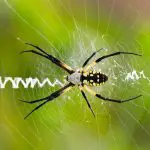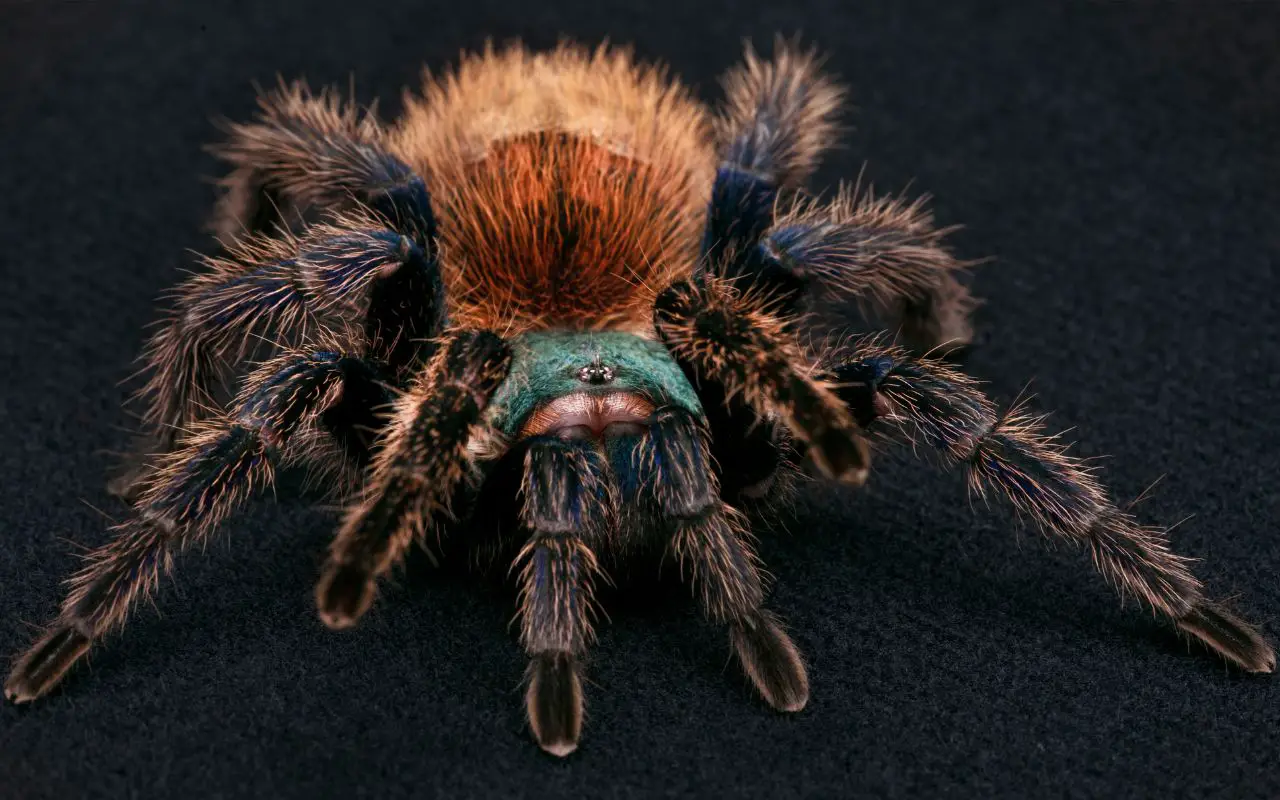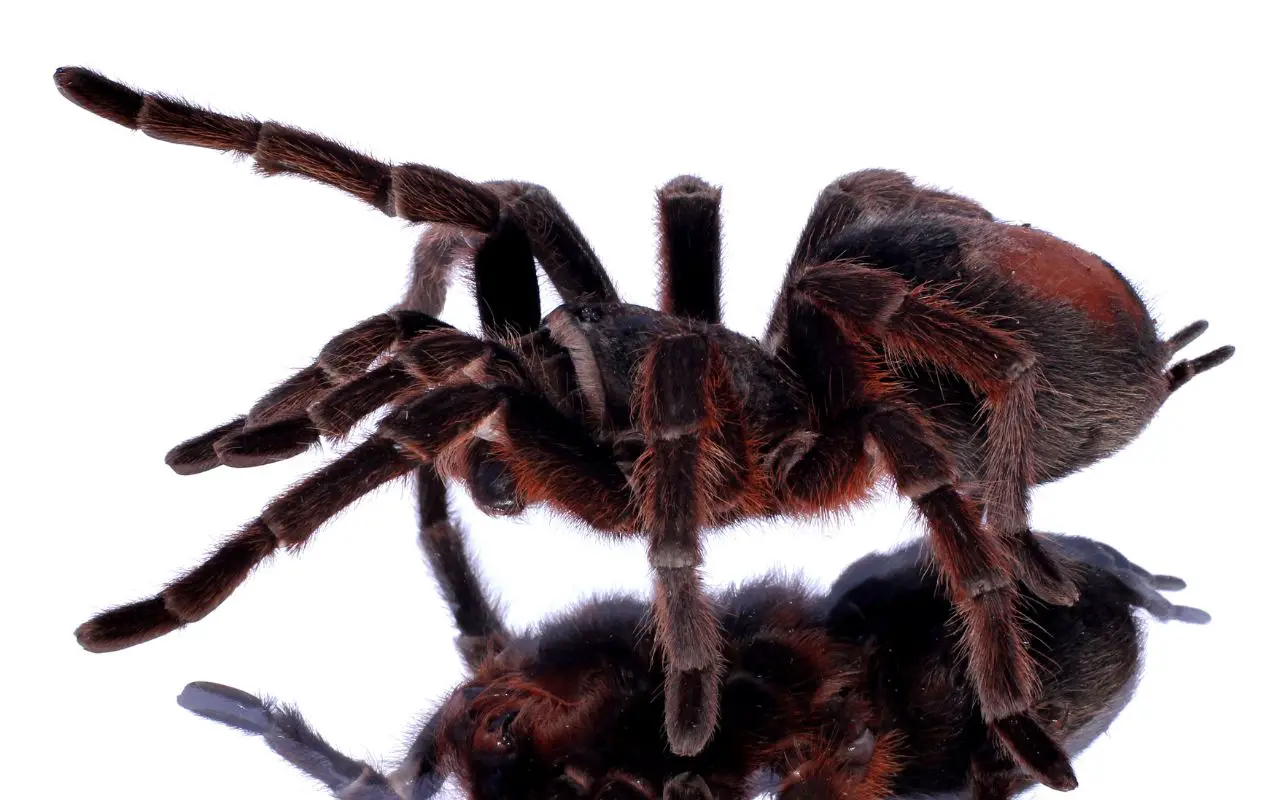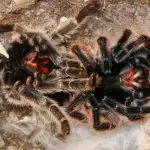Last updated on February 1st, 2023 at 10:08 am
The Green Bottle Blue Tarantula (Chromatopelma cyaneopubescens) is a hardy pet and spectacular to look at. Though it likes to climb it is from semi-arid regions, not rainforest…
A thorough Green Bottle Blue Tarantula care guide is vital to the health and wellbeing of your new pet. In this article, we’ll discuss what size enclosure is appropriate for your pet, how to set up a substrate and other details related to this tarantula’s habitat. We’ll also discuss whether they are arboreal and how to care for them in the right environment. Keeping a Green Bottle Blue in a properly maintained enclosure should pose no problems.
Green Bottle Blue Tarantula size
A Green Bottle Blue Tarantula is a medium-sized species, and highly attractive. It is best kept in a terrarium that is three times the size of its leg span. It must be securely fitted, with plenty of ventilation and foliage. A terrarium should also have an adequate water dish. The tank should be secure and free of drafts, and the substrate should be clean and dry.
This species is easy to care for and grows quickly. Although they are not aggressive, they can get very scared easily. When frightened, they might make sudden movements or throw urticating hairs, which can be painful or cause swelling.
In addition to being a fast-growing species, the Green Bottle Blue Tarantula can reach up to six inches in length.
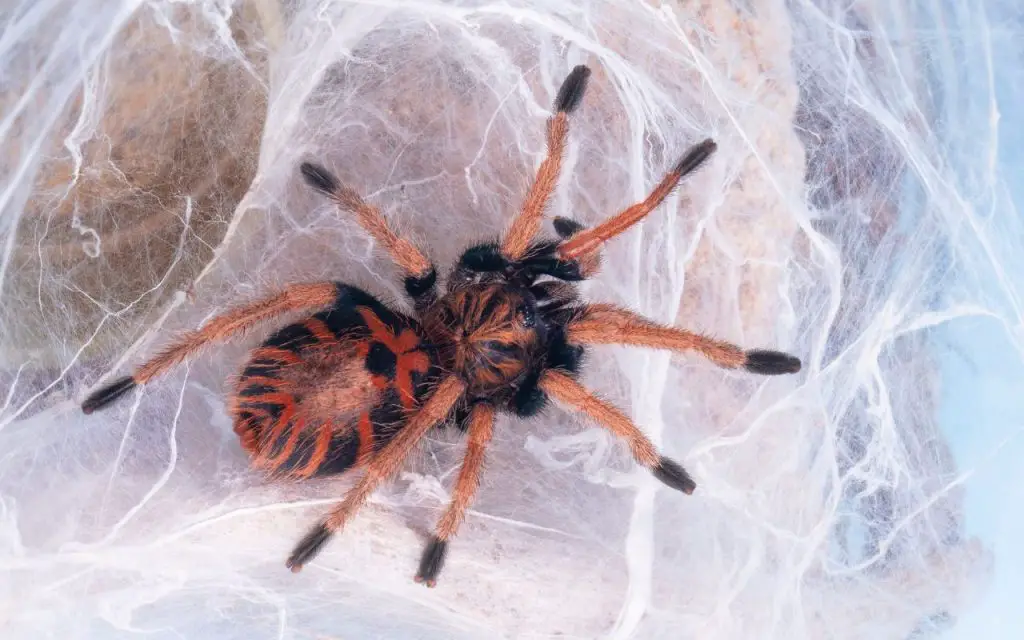
Are Green Bottle Blue Tarantulas arboreal?
This species prefers dry desert habitats and burrows into a variety of substrates. The most common substrate in captivity is dried coco coir (Eco Earth), but this species is also capable of living in a variety of other materials.
Though its habitat is arid, it contains a lot of shrubs. Green Bottle Blue Tarantulas are known to make their burrows at the base of these shrubs and climb into to them regularly. As such, you could say that they are semi-arboreal.
The main difference between arboreal and terrestrial species is that they have some adaptations for living in trees, which make them better suited to their environment. Arboreal tarantulas have long, thick scapulate pads that are covered with minute hairs.
The large scopulate pads enable them to move over bare tree bark and survive on softer surfaces. As a general rule, arboreal and semi-arboreal tarantulas are more delicate, and even if they are tame you should be careful handling them.
Green Bottle Blue Tarantula enclosure
The Green Bottle Blue Tarantula is native to the Paraguana peninsula in Venezuela, a region of the Caribbean Sea that is surprisingly arid. Its habitat represents arid desert scrubland and the spider evolved to withstand harsh conditions. While it may be shy and sensitive in captivity, this species is an adaptable and durable arachnid.
The first step in caring for a Greenbottle Blue Tarantula is to find a suitable enclosure for the creature. It must have the appropriate temperature, humidity, and substrate. If you’re buying one from a breeder or a rescue group, be sure to check local laws. Then, set up the terrarium for your new pet. Be sure to select one with sufficient floor space and ventilation.
A good quality plastic or glass terrarium with a well-ventilated top is essential for the Green Bottle Blue Tarantula. A five to ten gallon tank is ideal for this species. A front closure allows easy access to feeding and cleaning. Ensure that the glass container is not too deep or too wide as plastic can be a poor substrate. Clean water should be changed daily to ensure the health of the greenbottle blue tarantula.
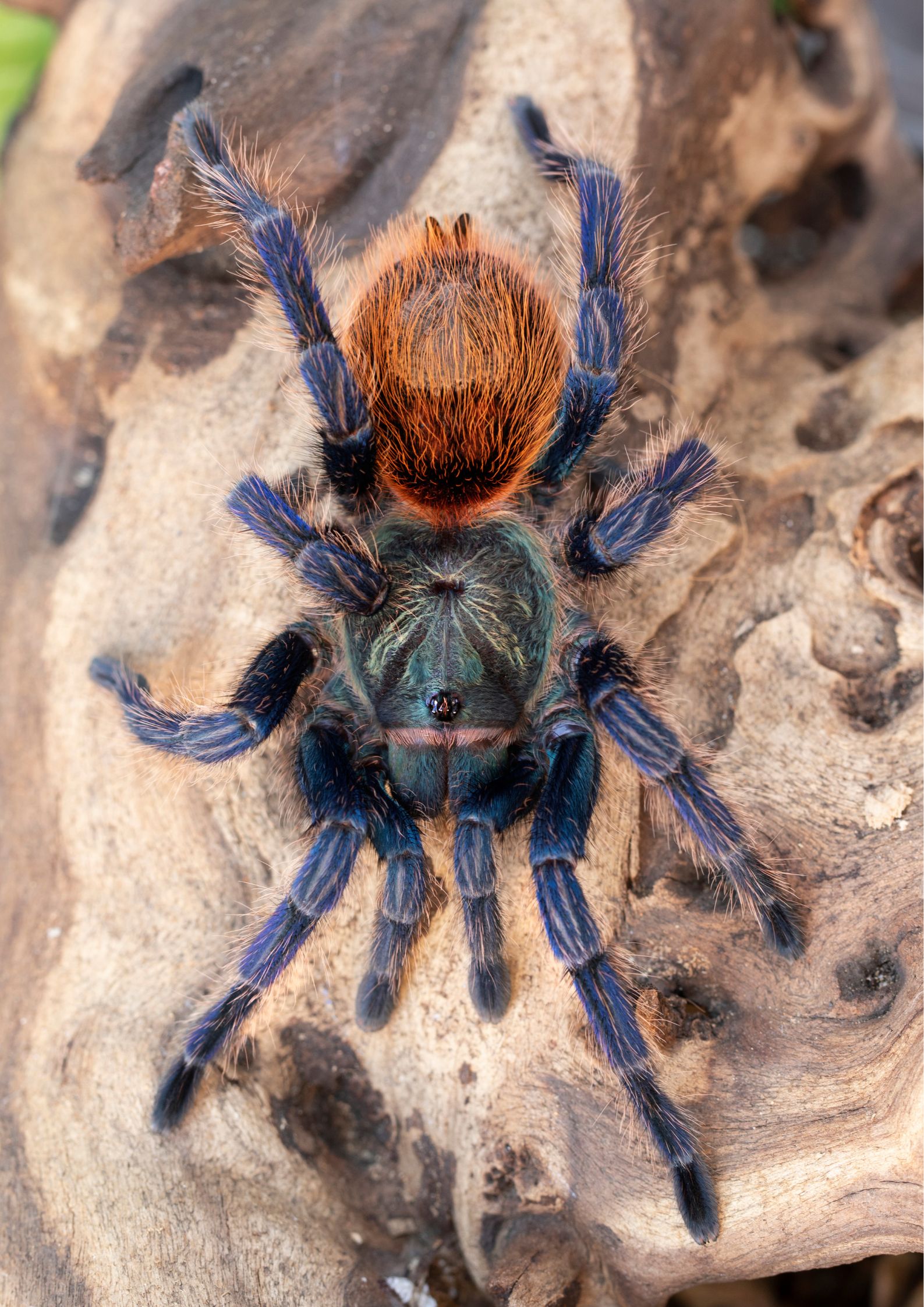
Green Bottle Blue Tarantula substrate
When choosing the substrate for a Green Bottle Blue Tarantula, the first thing to consider is the species’ physiology. This species thrives in a dry environment, but will appreciate a water dish full of water.
This type of spider also likes to burrow, so you should choose a substrate that is coco coir, soil or peat moss. Additionally, you can use bark as a hiding place if you like. Cork bark placed upright is a good climbing place as well.
To keep this species healthy, you should choose a substrate that is resistant to moisture and mold. Also, avoid cedar and sand, both of which can cause illness in certain spiders.
Good substrate choices include:
- coco coir
- peat
- vermiculite/peat mix
- sterilised topsoil
- coco coir or peat and vermiculite mix
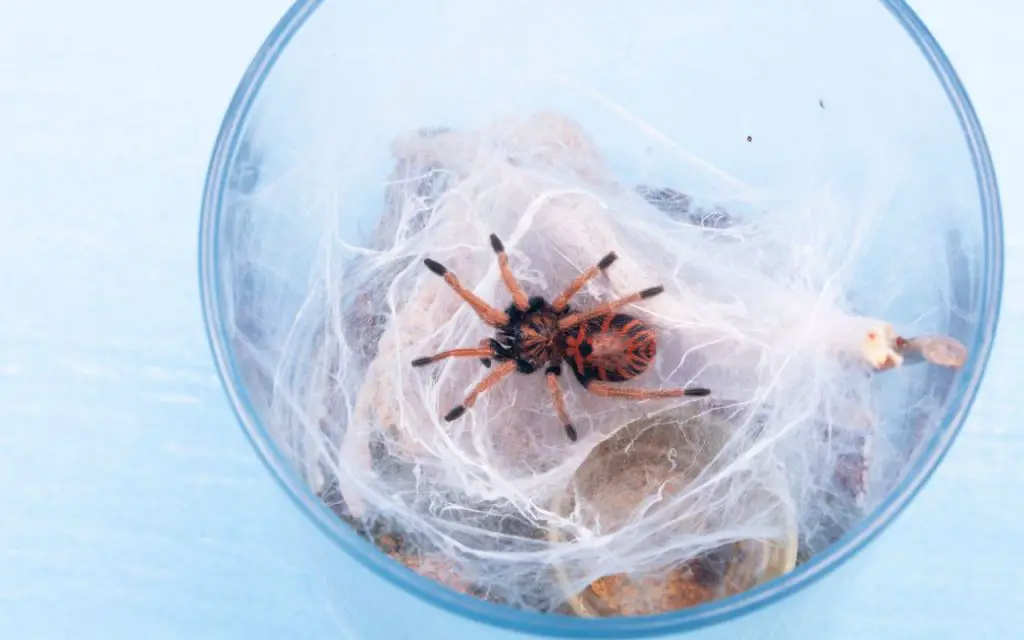
Temperature
The green tarantula doesn’t require special lighting, but it does need some ambient light. Just light from a window in the room – but not on the enclosure is fine. Don’t be tempted to provide a heat lamp, that is too much heat for this species.
The temperature of its enclosure should be around 65-77 degrees Fahrenheit. For most people, this is room temperature, so you never need to provide additional heat, unless your house gets very cold during winter. Its enclosure should be away from direct sunlight, which can dehydrate it and lower its humidity level to dangerous levels.
If you live in a cold climate, you can use heating pads under the substrate. However, heat mats may be detrimental to the tarantula. They should only be used if your house drops below 60f, and only with a thermostat to control them at a temperature of 75f.
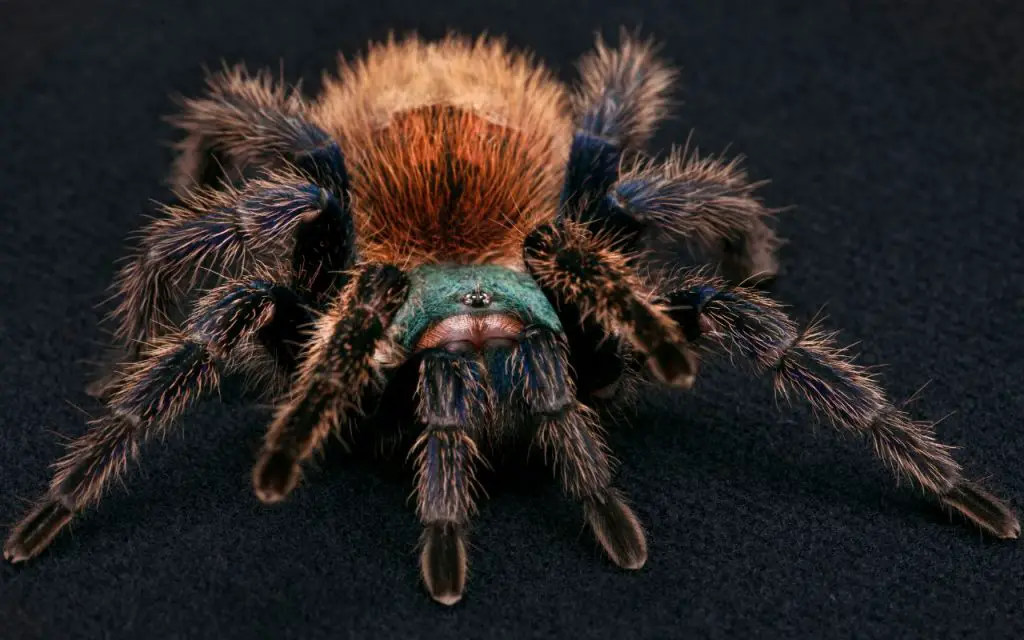
Water and Humidity
The best way to maintain the ideal climate for a Green Bottle Blue tarantula is to keep it at a consistent 50 to 60% humidity level. Though they are from arid areas, they do get some humidity from their burrows at night.
The Green Bottle Blue Tarantula is a large webber, so it may take a while for it to adjust to its new home. While the tarantula is generally healthy, it can develop problems such as molting problems. The best way to avoid this is to always maintain good humidity, and monitor it using a hygrometer.
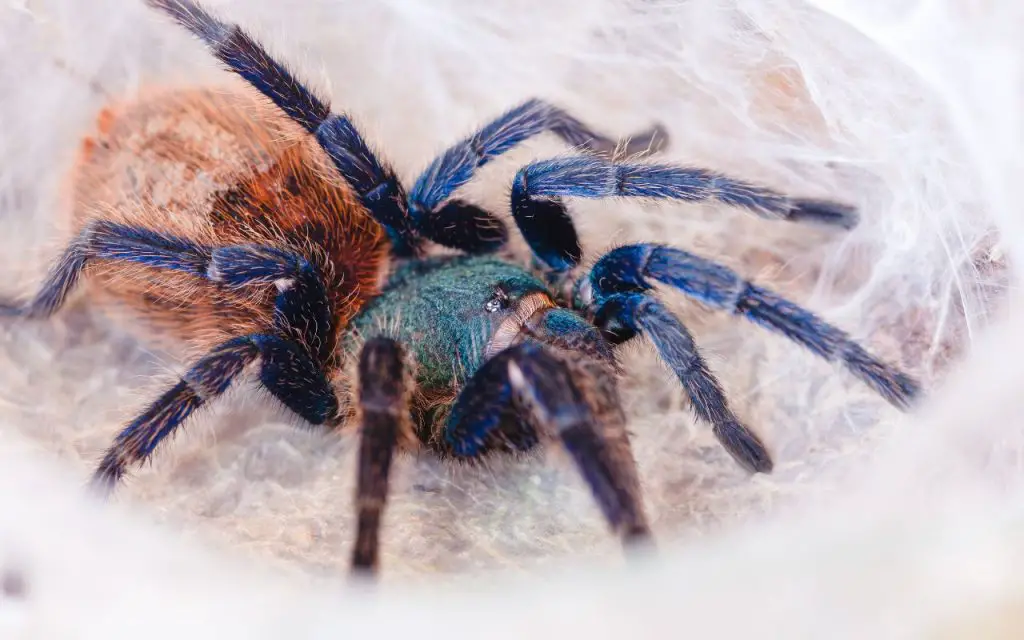
Green Bottle Blue Tarantula feeding
A Green Bottle Blue Tarantula is an easy-to-care-for tarantula with a good appetite. They do best when fed a varied diet of live insects. However, the biggest concern is that livefoods shouldn’t be left unattended in the enclosure, as they can injure newly moulted tarantulas.
Most of these spiders do well on a staple diet of crickets, which are available at most pet stores. Spiderlings can be fed pinhead crickets or fruit flies.
Since the Green Bottle Blue is a heavy webber, it will need to be cleaned out regularly. Once a month, you should remove trapped insects and dead bolus from its enclosure.
Green Bottle Blue Tarantula venom
The venom produced by a Green Bottle Blue Tarantula is mild and only causes itching and swelling. However, it can be dangerous if you get the tarantula’s hairs into your eyes.
Green Bottle Blue Tarantulas are great pets for beginners. While Green Bottle Blue Tarantula venom is mild, they are quite nervous and will not generally appreciate it if you try to handle them.
The Green Bottle Blue Tarantula is easy to care for. Most people who own them have a terrarium and feed them small insects like crickets. They never get bitten so long as the spider is given space and not bothered on a daily basis.
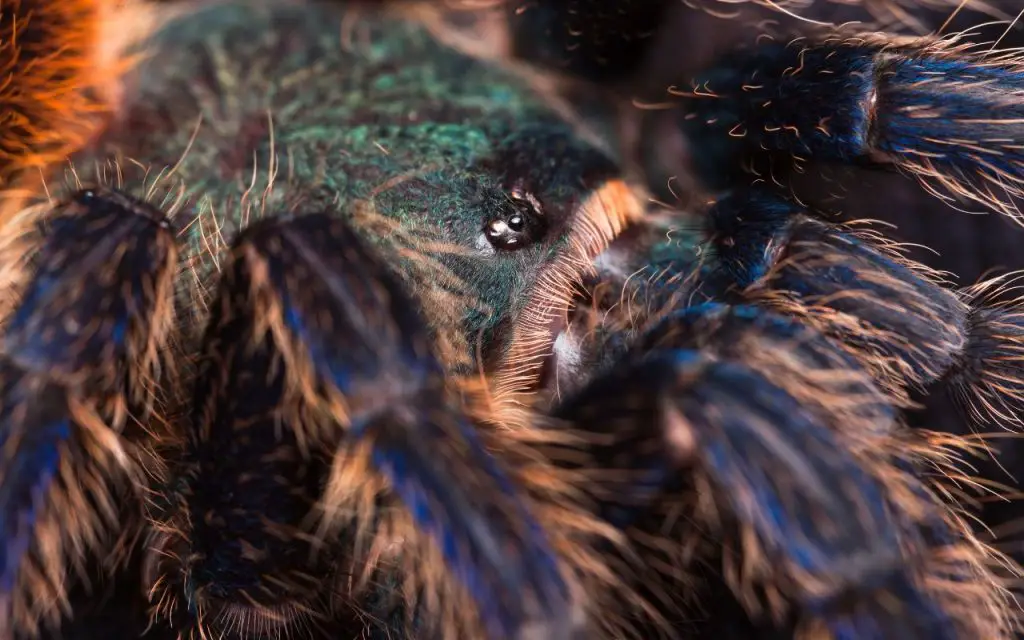
Green Bottle Blue Tarantula FAQs:
Why is it called Green Bottle Blue?
The Green Bottle Blue Tarantula is named for the beautiful irredescent green coloration of its cephalothorax, and the blue tinge that its legs have. These colors are most pronounced in adult spiders which are spectacular, and probably serve as a warning to predators that the spider is (mildy) venomous. This called aposematism.
Are green bottle blue tarantulas aggressive?
You can get an attack from this species if it feels threatened. However, a green bottle blue tarantula isn’t aggressive unless provoked. The spider is very quick-moving and has urticating hairs. Fortunately, they rarely use them.
This tarantula is also venomous to humans, and a bite will feel similar to a bee sting. If you’re worried about getting bitten or about getting urticating hairs kicked at you, then you should wear gloves and eye protection when cleaning or feeding.
How long do Green Bottle Blue Tarantulas live?
When it comes to lifespans, the female Green Bottle Blue tarantula can live anywhere from 12 to 14 years. While males can live up to 4 years, females are preferred for pets due to their longer life spans. If you want your tarantula to live as long as possible, provide it with stable conditions: no extremes of heat, cold or humidity.

